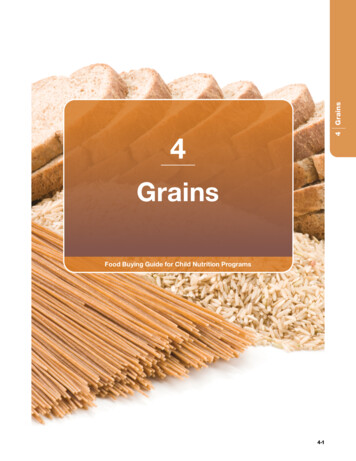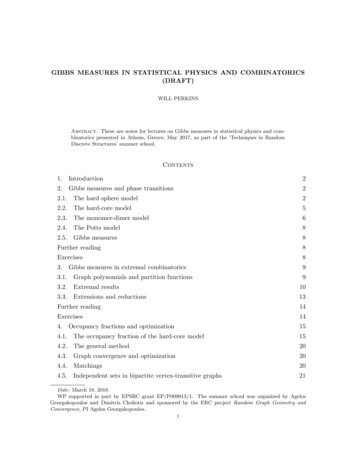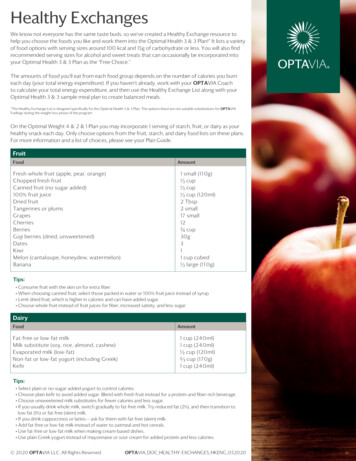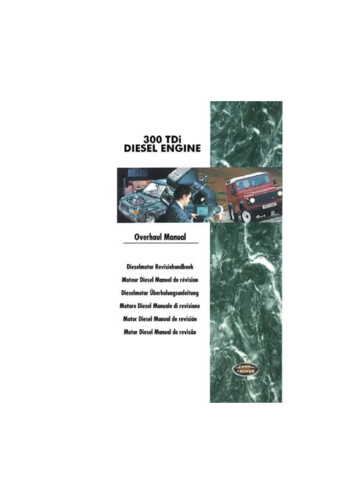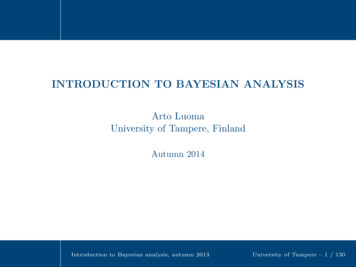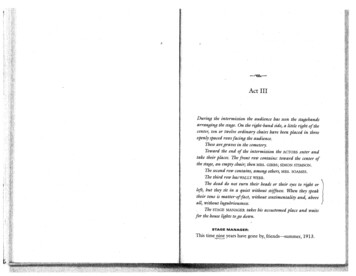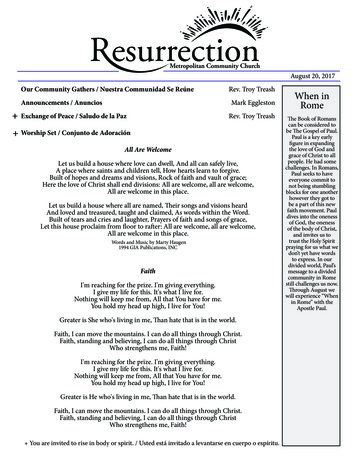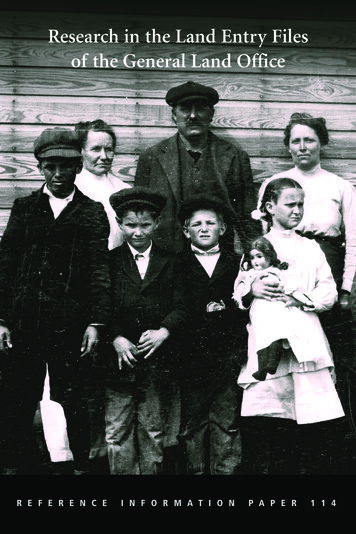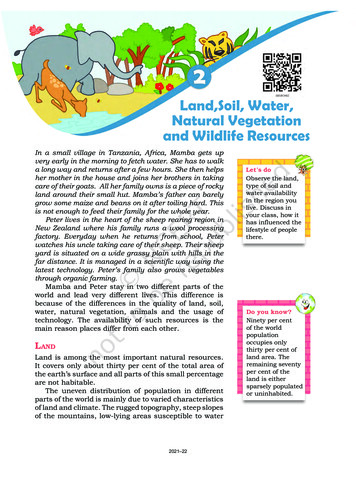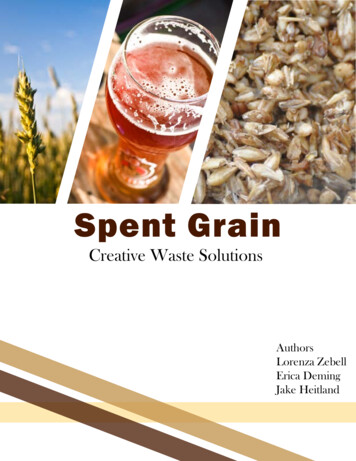
Transcription
Spent GrainCreative Waste SolutionsAuthorsLorenza ZebellErica DemingJake Heitland
Table ofContentsSo what are spent grainsanyway?4An overview of spent grains and whywasting them matters.Spent grain nutrition6See how spent grains can actually makefood healthier.Options to reuse spent grain:81 From beer to bread!Learn about how to use spent grains inbaked goods.2 Turning waste into abusiness12Read case studies of successfulbusinesses using spent grains.3 Other sustainable uses14Next Steps16Find out how breweries are putting theirspent grains to other creative uses.Simple tips on how to get startedresusing spent grains.
IntroductionWhy wasted food mattersIn America, it is estimated that 31-40 percent of all foodproduced is wasted each year. The Food and AgricultureOrganization of the United Nations estimates that NorthAmericans waste 1520 kcal/capita/day. That’s three fourths of ahealthy 2,000 kcal diet wasted, while one in six Americans stillstruggle with hunger. Because of this carelessness, wasted foodis the largest part of municipal solid waste in U.S. landfills. Theorganic material decomposing in landfills releases the powerfulgreenhouse gas methane, contributing to 16% of the U.S.’sgreenhouse gas emissions. These factors make food waste a uniqueopportunity to address social and environmental issues.
“6 billion poundsof brewers grainsare produced in theUnited States eachyear, and much of thatsimply gets landfilled.”4
So what are spentgrains anyway?5mostFeed Hungry PeopledesSource ReductionirableEPA Food RecoveryHierarchyFeed AnimalsIndustrial UsesCompostingLandfill/IncinerationesirableSpent grains, also known as brewer’sgrains, are the coproduct of brewing beer.They may comprise of wheat, maize, rice,sorghum, millet, or barley, the most commonly used in the United States. At thebeginning of the brewing process, the grainsare milled (crushed) and soaked in water,which absorbs the sugars. The resultingsugary liquid, wort, is drained away, brewedwith hops, and fermented. The grains exitthe process at an early stage, and never comeinto contact with alcohol.The grains are wet and drained of sugars,but are still good sources of fiber and protein3. Some researchers even claim that thismakes for a healthier bread (fewer sugars,fewer calories).Traditionally, brewers have allowed farmers to pick up grains for supplemental animal feed. However, many growing breweriesare finding it increasingly difficult to giveall of their grains to farmers, and resort todisposal. With six billion pounds of brewersgrains produced in the United States eachyear, that’s a lot of waste! For every six packof beer, one pound of grains are generated,much of which is landfilled4.Today, breweries, bakeries, and homebrewers are realizing the potential in thesegrains and redirecting them for human consumption. In alignment with the FDA’s foodrecovery hierarchy, we feel that redirectingthese grains from animal feed to human useis a more valuable use of calories. In thisguide we illustrate several options for reuseof these grains. We hope to inspire innovative breweries and bakeries to prevent thismassive waste and use spent grains to theirhighest potential!least dBrewing WasteIn this guide we refer to thishiearchy when analyzing thevirtue of a spent grain reusemethod. Because less beer isnot an option, we see feedingpeople as the best alternative!
Spent GrainNutritionA delicious ingredient that canactually make food healthierHealthy meansmarketablewaste solution appeals to the environmentallyconscious consumer. Turn the page to learn thatwhile spent grains are healthy and sustainable,they’re also tasty!According to a report by the Journal of Cereal Science3, replacing regular flour withspent grain in a loaf of bread will double thefiber content, increase the protein content by50%, increase the essential amino acid contentby 10%, and decrease the calories by about7%. This drastic change in the nutritionalcontent of the bread is truly remarkable, andcan be marketed to a specific market segment.Consumers interested in Lifestyles Of HealthAnd Sustainability or LOHAS are a huge andgrowing segment of the market. With as manyas one in four North Americans a part of thisgroup, these incredible nutritional benefitswill be attractive to many people. Additionally,reusing spent grains as a sustainable food6
When replacingregular white flour in astandard loaf of bread,spent grains will.double the fiber contentdecrease the calorie content 7%increase the protein content 50%increase the essential amino acidcontent 10%7
1From beer tobread!Creative & delicious uses in the kitchenSpent grain open up lots of creative ways to rework beloved recipes. Use abatch of chocolate stout in a pan of brownies, or grains from a nut brownstout in your old banana bread recipe! You can use spent grain in as manyrecipes as you can use flour; when dehydrated and ground, spent grainsbecome just that! We want to highlight a few that do not require theselonger steps. Here is just a taste of the many recipes that incorporate themoisture and texture of spent grains straight from the brewery for a flavorfulnew result.German Beer BreadWho better to ask how to bake bread with brewer’s grains than Germany? This simple recipe includes almost a full bottle of beer, and results in a flavorful loaf with a satisfyingly crispy crust.Ingredients1 cup fresh spent grains2 cups white flour8 ½ oz. beer1 packet yeast1 Tsp. saltInstructionsMix everything but the salt together. Letrise for one hour. Stir in salt. Let rise forfifteen more minutes. Bake in buttered breadpan at 430 degrees Fahrenheit for an hour.8
Ingredients½ cup butter1 cup sugar¼ Tsp. salt1 cup cocoa powder1 Tsp. vanilla extract2 eggs½ cup white flour½ cup wet spent grains⅔ cup chocolate chipsBrownies, spentgrain style!InstructionsMelt butter and stir with sugar and salt. Stirin cocoa powder, then the eggs and vanilla.You could hide anything in a brownie, but spent Stir in white flour and mix well. Add wet spentgrains actually make them better! This recipegrains. Add water if batter is too thick to spreadcreates a thick, textured brownie that’s satisfying to make a runny batter. Bake in a greased 8”x8”to bite into.pan at 350 degrees F for 35 to 40 minutes.9
Banana BreadThis seemingly ordinary banana bread recipebecomes something completely new with spentgrains! Namely, a hearty, textured short breadwith a delicious nutty flavor.Ingredients1 cup spent grains¾ cup all purpose flour2 Tsp. baking powder½ Tsp. salt5 T. butter¾ cup sugar2 over-ripe bananas2 eggs½ cup chocolate chipsInstructionsMix together wet ingredients in one bowland the dry ingredients in another. Add the drymixture to the wet ingredients. Add chocolatechips. Pour into buttered loaf pan and bake at350 degrees F for about 30 minutes.10
Drunk PizzaIngredients1 packet active dry yeast½ cup warm water at 110 degrees F1 ½ cups flour¾ cup spent grain1 ½ Tspn saltOlive oilInstructionsGently mix yeast into water, let sit for fiveminutes to bubble. Add flour, spent grain andsalt mixture and knead by hand or with mixerfor 8 to 10 minutes.Place dough in a bowl lined with olive oil.Cover with a towel and leave in warm placefor about two hours.Shape dough into pizza crust shape overfloured pizza pan or stone. Add toppings andbake at 475 degrees F for about 20 minutes.Spent Grain FlourIngredientsThe spent grains of your choice!InstructionsSet your oven to its lowest setting (170200 degrees). Spread out the grain in a 1/4inch thick layer on a pan. Any thicker andthe grains may not gry properly, so keep itthin.Dry the grains in the oven for about 7hours. You can also use a food dehydrator.Toss about halfway through the 7 hours.This seven hours will vary depending onthe humidity of your area. More humidityand you will need more time. The grains aredone when they are completely dry!A coffee grinder, spice grinder, or foodprocessor will grind the grain into a flour.The flour can be stored and used likenormal flour! We reccommend an airtightcontainer in a dark place. This flour will keepas long as regular flour, so up to 2 years!11
2Turning waste intoa businessProfitable ways to use grainsOverviewThe US generates six billion pounds ofspent grains every year! In the wake of somuch waste, bakeries, breweries, and homebrewers are finding new ways to incorporatethese grains in their businesses. Bakers havepartnered with brewers for access to the plentiful grains, creating new and healthy snacks fortheir shops. Our vision is a closed loop systemin which brewers and bakers share spent grainsand baked goods; both businesses profit from anovel product and work to mitigate food wasteall at once! The following page provides anoverview of three business ventures that repurpose spent grains in unique ways.12
RegrainedA number of entrepreneurshave built their business on thegrowing interest in spent grains.One such company, Regrained,is a San Francisco start-up thatcollects spent grain from localbreweries to bake into granolabars.They market their business as a sustainable and ethicalproject grounded in local activism with their mantra “Brewgood. Eat good. Do good.”They partner with localbreweries, incorporate organicingredients, and strive to usesustainable packaging. They’veidentified urban breweries asparticularly suited to their market model, as they are often toodistant to give their grains tofarmers. However, they currently occupy a narrow cornerof that market, limited by size,locality and high prices. Thereis still plenty of room for morespent grain entrepreneurs!Brew BonesHewn BakeryHewn Bakery is an artisan bakery run by classically-trained chef Ellen King andbusinesswoman Julie Matthei inEvanston, Illinois. Their missionis to provide sustainable preservative, chemical, and additive-free bread to their community. They use 100% organicingredients, and bake bread in atraditional stone oven.The bakery features a spentgrain bread as a regular part oftheir offering, and report major success with it. Their use ofspent grain proves that bakeries can source spent grainsfrom local breweries inexpensively and incorporate theminto their regular breads withgreat success!13California residents HeloiseLove and Jennifer McFaddenstarted Brew Bones, a spentgrain dog biscuit business,when Love’s older dog contracted a rash as a result of commercially-made dog food. Lovesolved the issue by switchingher pup to a homemade biscuitdiet. Love and McFadden decided to make a business outof the biscuits to bring healthytreats to dogs everywhere.They pride themselves onthe short ingredient list of theirbiscuits, just peanut butter,brown-rice flour and flaxseedmeal, and spent barley grainssupplied by local breweries. Thecompany has grown quickly,selling dog treats on location inseven states as well as online.
3Spent Grain PathwaysOptions for spent grain, indescending order of sustainabilityAnimal FeedFor as long as beer has been brewed, brewers and farmers have worked closely together. In this age-old friendship, farmers collectbrewers’ grains at little or no cost. It’s a matchmade in heaven: farmers get a nutritious andcheap food source for cows and pigs, andbrewers are saved the trouble of disposing ofthe seemingly useless coproduct of brewing. Incomparison to a compost pile, an incinerator,an anaerobic digester or the landfill, animalfeed is a better destination for spent grains,because it brings some of their nutrients backinto the system. However, we find that breweries are outgrowing this relationship, leading tomore spent grain waste. For urban breweries,the distance from rural farms has impeded afeasible partnership, given that the highly perishable wet grains cannot travel too far. Mostof all, we are concerned with redirecting spentgrains to human consumption, the most valuable use of this overlooked food source.14
Energyremote location in Juneau, Alaska, the economicand environmental cost of shipping their grainDeriving energy from spent grain waste is the to farmers for feed makes that an undesirablenext most sustainable option. One innovativeoption as well. A more sustainable option forbrewery is closing the loop on their spent grain breweries looking to generate energy out ofwaste flow and directing it right back into their their spent grains would be through anaerobicdigestion, a biological process that breaks downoperation by turning it into energy! Tired oforganic material into biogas for energy and athe expensive process of drying their grainsand shipping them out to farms, the Alaskansolid co-product that can be used for compostor fertilizer.Brewing Co. purchased a custom 1.8 millionfurnace that burns their spent grains, makingsteam that powers most of their brewery. Thissystem offsets the brewery’s energy costs bynearly 450,000 each year. That’s about a 70%savings!This closed loop design is an unique solution;however, on the EPA Food Recovery Hierarchyincineration is the least desirable form of wasterecovery. However, given the brewery’s fairlyCompostingThe next most sustainable destination forspent grains is the compost pile. Grains andother organic materials can offer up nutritiousfertilizer perfect for gardens and urban greenhouses all across the country. The MilwaukeeBrewing Company understands this well, asthey give their spent grains to Growing Power,a national nonprofit focused on equal access toquality food.Although this ultimately results in the production of food for human consumption, theenergy lost from composting places this optionnear the bottom of the EPA’s food recoveryhierarchy. The least sustainable use ofspent grains is tossing them ina landfill!15
Next StepsBrewersDo you have a brewpub for your brewery? Try incorporating spent grains intoyour menu. If you source your bread and baked goods from a bakery, talk to themabout starting a ‘discount spent grain for discount baked goods’ exchange. If youdon’t have a brewpub, try contacting your local bakery and talk to them about spentgrain reuse. Who knows, it may be the start of a fruitful partnership! Are you ahomebrewer? Save some spent grains from your next batch of beer to bake with.BakersBreweries are a vast resource for a tasty, healthy, and inexpensive ingredient foryour bakery. Call up your local breweries and talk about spent grain. It’s possiblethey need someone to take it off their hands! Making baked goods with spent grainis a simple and novel way to create a unique product.Find us online at www.gibbs-lab.com/foodwaste to get a digital copy of this reportand a contact directory for Wisconsin brewies and bakeries.16
To Do:1. Call Local brewery orbakery2. Meet to set up arelationship to exchangespent grain3. Choose how to reusethe grain (bake with it!)4. Create product5. Market product as asmart use of waste!17
Meet the authorsStudents for a sustainable worldErica Deming is majoring in Environmental Studies andGender and Women’s Studies at the University of WisconsinMadison. She studied abroad in Germany and Jordan,learning the languages at least well enough to order aBerliner or Falafel. She is excited to work on the food wasteissue, because it opens up a unique form of environmentalactivism that everyone can participate in. In the future, shehopes to continue studying gender and environmental issues,because she believes that they intersect in meaningful ways.Lorenza Zebell is interested in triple bottom line, systemsthinking, management, and most importantly the ways inwhich these intersect with sustainable development. Sheis an Operations and Technology Management major atUniversity of Wisconsin Madison, and is also earning acertificate in Sustainability. She has significant experiencewith creative problem solving and leadership from her timerunning WSUM 91.7 FM, UW Madison’s award winningnonprofit radio station. She’s optimistic and excited for whather future holds!Jake Heitland is a graduating senior at University ofWisconsin - Madison studying Real Estate & Urban LandEconomics with an additional Certificate in Sustainability.His passion for creating a greener future through changingperceptions on what the built environment can andshould achieve shows as he seeks a career in sustainabledevelopment. This resource guide allowed the marriageof two other personal interests - reducing waste and beer- to come to life in a tangible way to create value for thoseacross the industry and start new conversations in a systemsthinking manner.
About This GuideThis was created as a part of a University of Wisconsin-Madison environmentalcapstone class dedicated to mitigating food waste on a local and global level.For more information and to download a digital copy visit:www.gibbs-lab.com/foodwasteSources:1Neff, Roni A, Marie L Spiker, and Patricia L Truant. “Wasted Food: US Consumers’ Reported Awareness, Attitudes, andBehaviors.” PloS one 10.6 (2015): e0127881.2Gunders, Dana. “Wasted: How America is losing up to 40 percent of its food from farm to fork to landfill.” Natural Resources Defense Council (2012).3Mussatto, S.i., G. Dragone, and I.c. Roberto. “Brewers’ Spent Grain: Generation, Characteristics and Potential Applications.” Journal of Cereal Science 43.1 (2006): 1-14. Web.4Associated, Press. “Brewers Find Crafty Ways to Use Spent Grain from Beer.” NY Daily News. NY Daily News, 29 May2014. Web. 23 Apr. 2016.5Conscious Wave, Inc. “LOHAS Background.” http://www.lohas.com/about. Web. 23 Apr. 2016.19
Thank you!20
Why wasted food matters Introduction In America, it is estimated that 31-40 percent of all food produced is wasted each year. The Food and Agriculture Organization of the United Nations estimates that North Americans waste 1520 kcal/capita/day. That’s three fourths of a healthy
